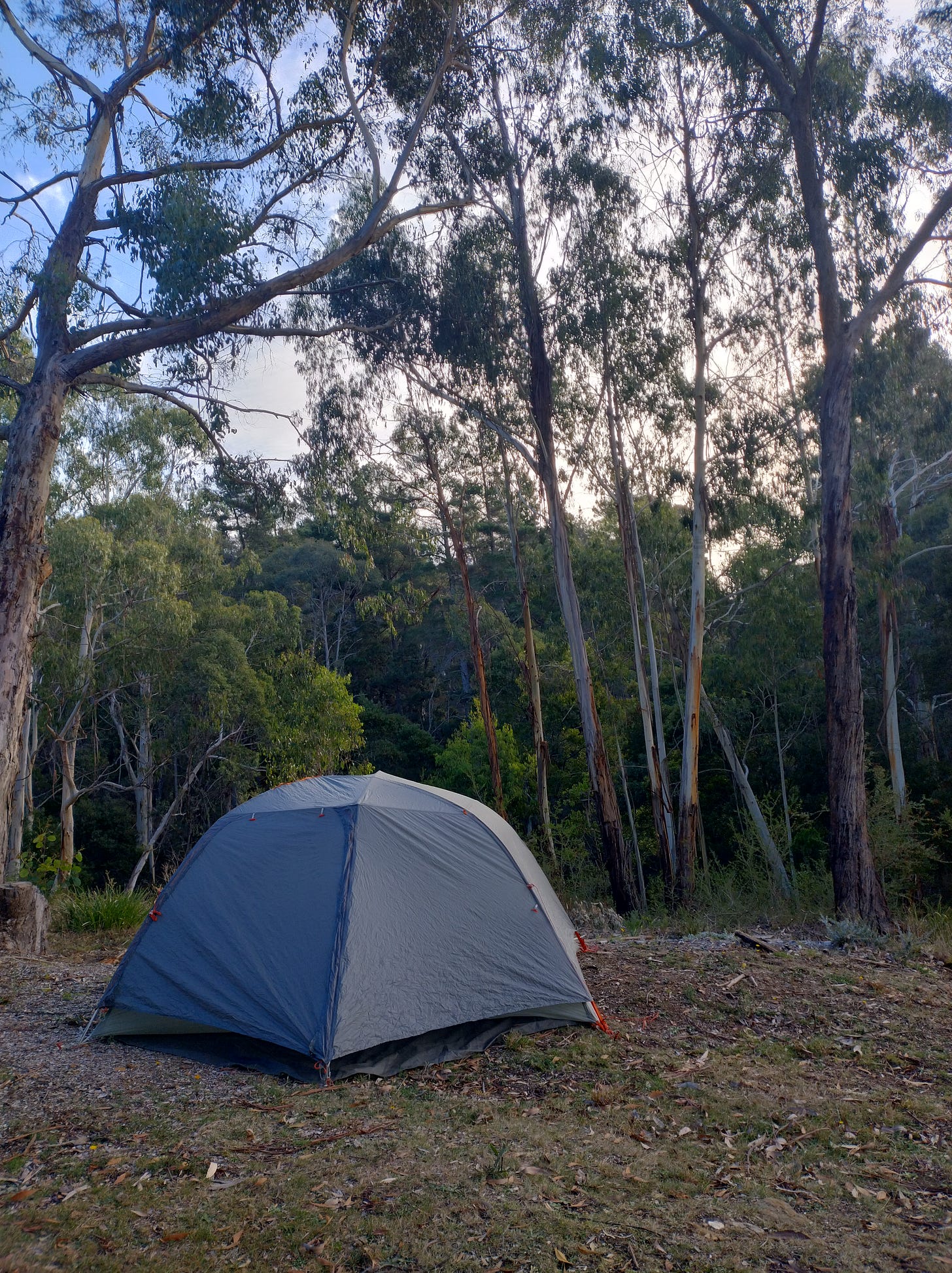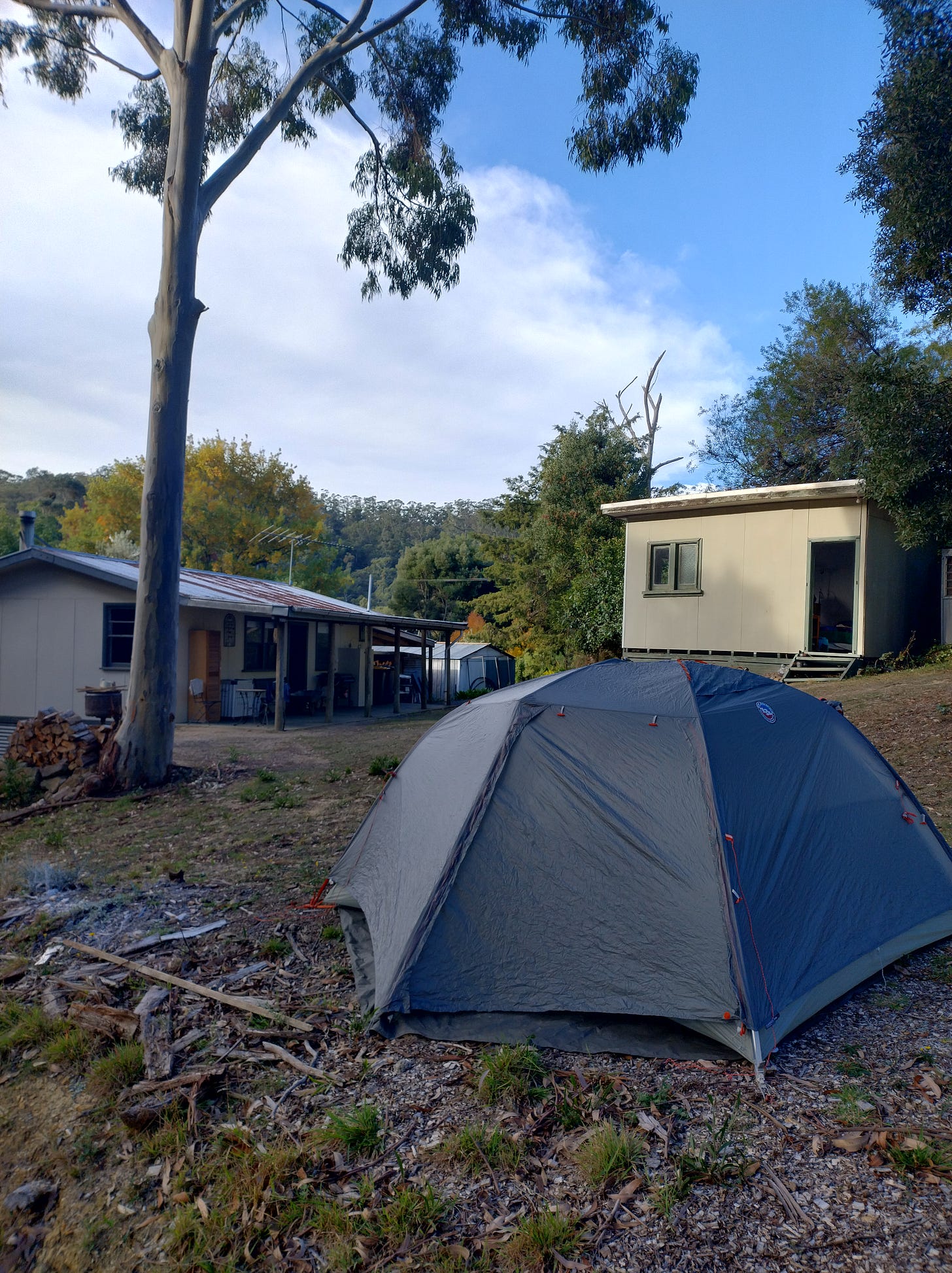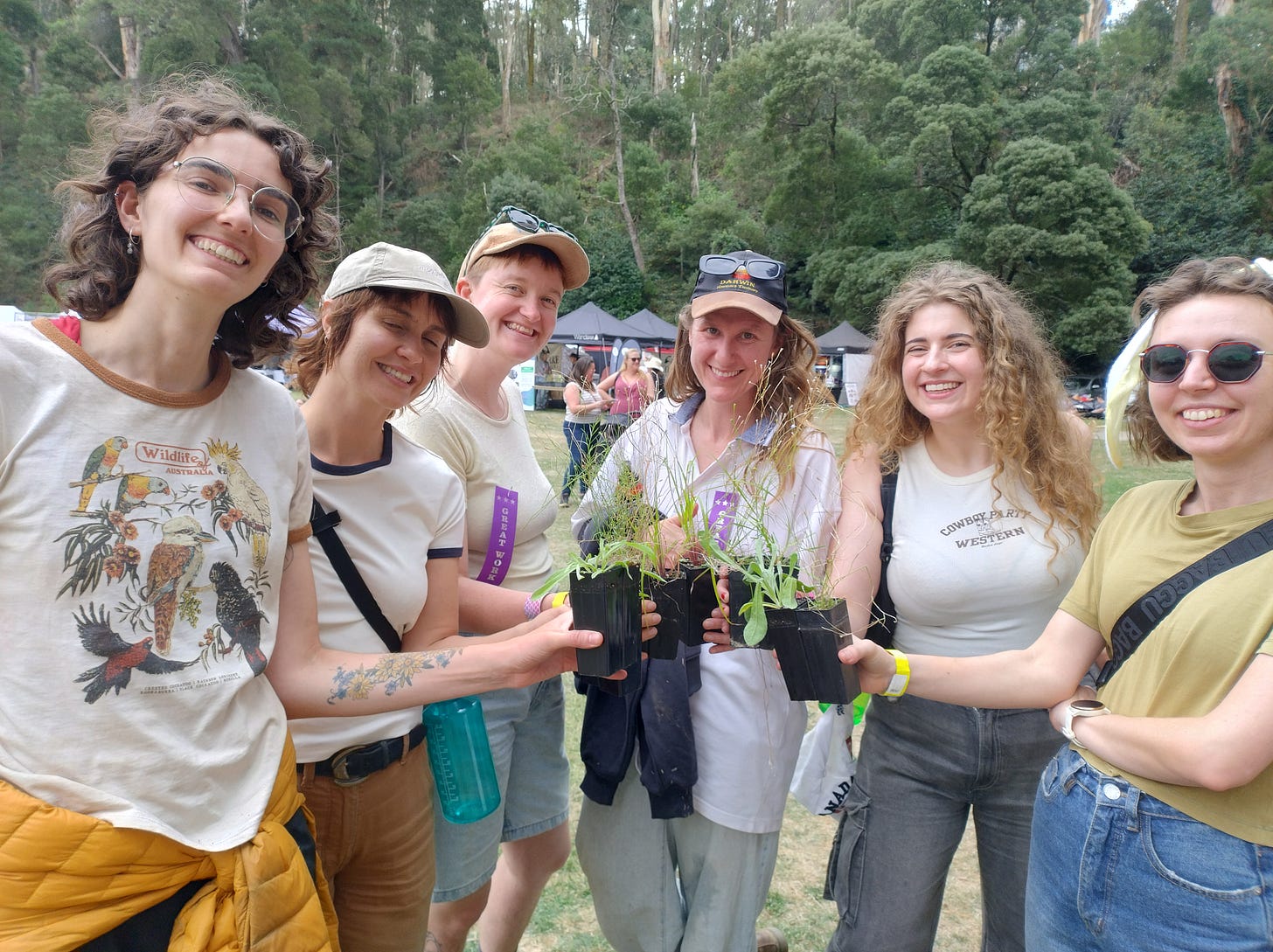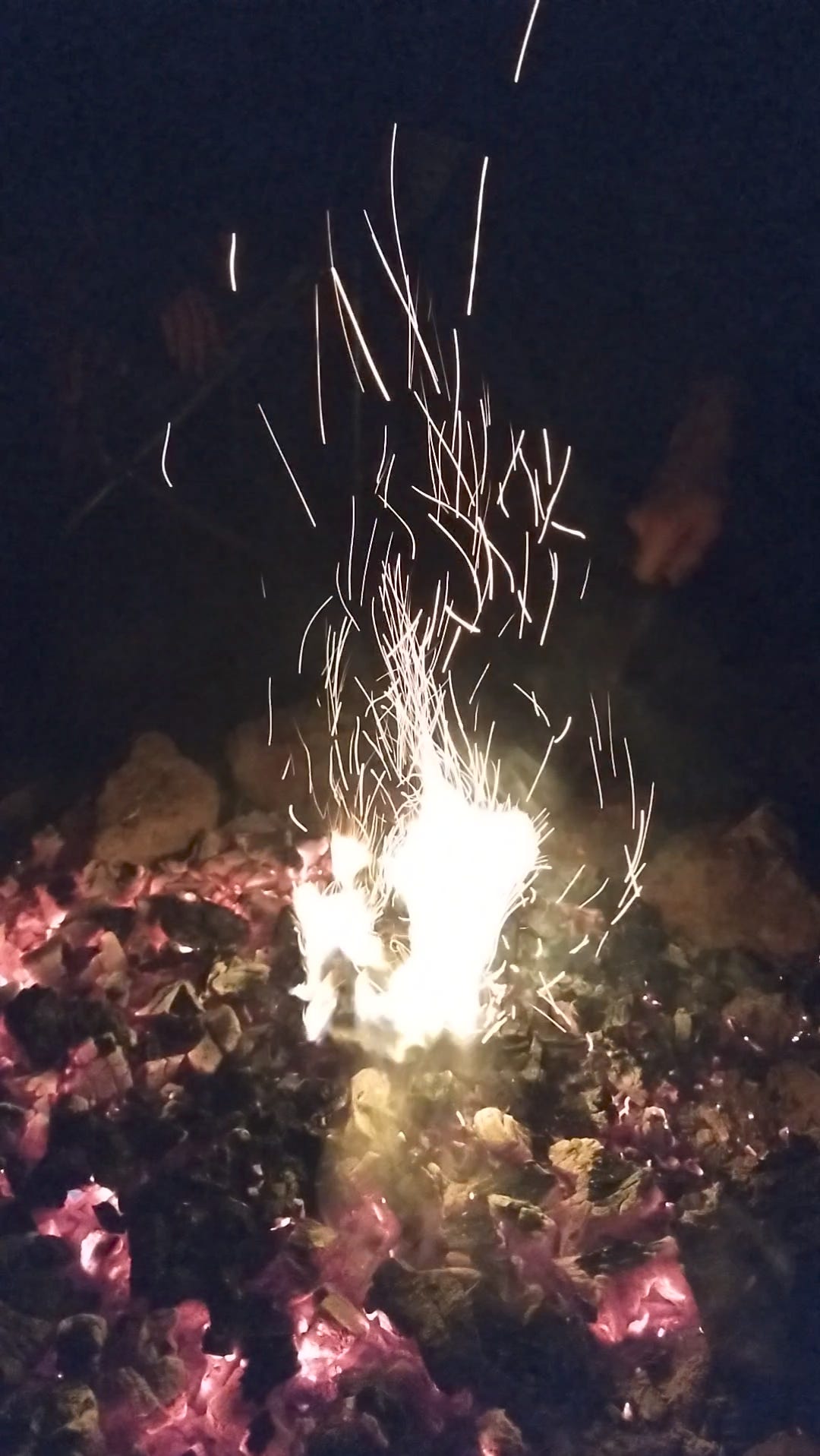Goldfields Hike(?) Part Three
A week of rest in Blackwood
Part three of my adventures and reflections incoming - see parts one and two for more context.
Any words in language or stories that I share here have been made publicly available along the track by Djaara Balaki Wuka, in the Goldfields Track guidebook or online. I give my sincere gratitude for the cultural gifts that have been shared in this way along the trail, and acknowledge full credit and custodianship of these stories to Djaara, their ancestors and peoples of neighbouring language groups.
Day 15 - Blackwood
I woke up this morning in the familiar back room of the house in Blackwood - and so began a new era in this adventure of mine. Getting up to go to the toilet this morning revealed that I made the right choice in giving my body the chance to rest, because my ankle was already complaining about that short journey.
Last night I had a big cry, ate some chocolate and watched an episode of Survivor. It was what I needed to celebrate how far I've come and also adjust to the changing circumstances of my environment, mind and body. I’m feeling more at peace in the misty light of a new day, hearing the familiar sounds of Blackwood birds and smelling my favourite air. As I sat to meditate earlier, a flock of choughs gathered in the tree in front of me. I have grown to love these birds in the last couple of weeks with their slightly freaky red eyes, their surprise white wings revealed beneath black as they take flight and the fact that they are always hanging out together in community. They seem to enjoy chatting, eating and singing together, and just generally being in each other's presence. As Easter approaches, I’m looking forward to some of my own flock coming here so that we can do the same.
This afternoon, I set up my tent in the yard. It felt right, and a way of keeping the adventure alive like when we camped in the backyard in suburban Melbourne as kids. I’m channeling the mermaid magic, and finding ways to continue what I wanted out of this time, one of which was to live more simply in closer relationship to the land. I love my tent home. The other thing I want out of this time is to continue learning and reflecting on history and complicity. So I got online, and it turns out there was an article published TODAY about the Djaara signage I have been learning from on the walk - how lucky I am to have timed my hike so closely to this project coming to life. It feels like it was meant to be, and I hope I can go back in sections once all the signage is installed. The stories are accessible on the Goldfields Track website. I also started reading about the history of the Loddon Aboriginal Protectorate north of Lalgambuk (Mt Franklin). More on this tomorrow.
Today I am reminded that when we are driven by our values, but flexible about specifics, it gives us an amazing capacity to adapt and change plans.
Day 16 - Blackwood
I have been reading more this morning about the Loddon Aboriginal Protectorate. There is a lot to unpack, but I will try to summarise some key points and provide links for further reading.
The invasion of the lands of the Kulin nation around Port Phillip Bay began in earnest in the mid to late 1830s, mostly by pastoralists coming from lutruwita (Tasmania, or what was then known as Van Diemen's Land). In a misguided and disastrous attempt to “protect” First Nations people from frontier violence as had occurred in lutruwita, the Aboriginal protectorate system was established in 1838. The idea was to split the growing settlement around Port Phillip into four regions each with a dedicated area of 5 mile radius to concentrate Aboriginal people, “civilise” them and teach them Christianity. A famously great way to protect someone - steal their home and then try force them to abandon their entire culture and identity too.
George Augustus Robinson, who already had a track record for violence in lutruwita, was designated Chief Protector, with an Assistant Protector for each region being Edward Stone Parker in the area of what is now northwestern Victoria. Much of what was written about the Loddon Protectorate comes from the diaries of these colonial men. The site for the Loddon Protectorate was eventually chosen at Franklinford in an area north of Lalgambuk known to Djaara as larne-ne-barramul (habitat of the emu).
The protectorate was an area that was partly cultivated and partly available for hunting. At its peak there were around 200 to 300 people there, mostly Djaara, and at various times there was a school, wheat fields, sheep run, church and a homestead. By the time the protectorate was established, settlers had been stealing and clearing land for sheep runs for about five years violently dispossessing Djaara and neighbouring language groups. The main thing drawing First Nations people to the station was food and medicine, both of which had been abundant on Country before it was decimated and new diseases brought here. Aboriginal people who did come to the station did unpaid labour next to their paid white counterparts. Parker did try to prosecute a group of men in 1840 and again in 1841 for killing Aboriginal people in the area, but the courts wouldn't listen to evidence provided by First Nations people because they were considered heathens who couldn't swear on the Bible.
Although he sought justice for these deaths through a racist judicial system and seemed to care in his own way, Parker committed deep acts of cultural violence himself through attempts of “civilisation” and “christianisation”. Despite great acts of resistance and doing whatever was possible to survive many Aboriginal people were murdered or died during this period of huge land grabs by settlers, and conditions within the protectorate were dire. A governmental select committee recommended the closure of the protectorates in 1849 due to their complete failure, but there was no alternative offered and the government essentially tried to ignore the ongoing violence towards Aboriginal people for the next decade. During this time Parker applied for and was granted 642 acres to continue on a smaller scale and some Djaara decided to stay on at this new Mount Franklin Station. In the end, greed for more land and gold led to these lasting Djaara on Djandak being forcibly removed to Coranderrk.
Links:
https://deadlystory.com/page/aboriginal-country-map/Community_Places/Loddon_Station
https://barrygoanna.com/2022/10/24/loddon-aboriginal-protectorate-legacy/
https://www.egold.net.au/biogs/EG00042b.htm
https://www.egold.net.au/biogs/EG00076b.htm
Day 17 - Blackwood
Last week when I was learning about Chinese people on the Victorian Goldfields, I found out that during the gold rush in California, America was known to Chinese miners as Gold Mountain (金山). So of course as that gold dried up and the attention turned here, Australia was known as New Gold Mountain (新金山). Naturally, the anglicized pronunciations in the guidebook were inconsistent and didn't seem trustworthy. Also, naturally, it was easy to find the Mandarin pronunciation on Google (Xīn Jīn Shān) but far more difficult to find one in Cantonese which would have been the main language spoken by the people on the goldfields given the part of China that most came from, alongside Hokkien. This googling did lead me to discover an SBS drama called New Gold Mountain, which is a four-part series retelling the stories of the goldfields from the Chinese perspective, as opposed to the way that this history is portrayed by white people.
I’ve watched the first couple of episodes and without giving away spoilers I'd like to reflect on some examples of violence and racism. Chinese people were referred to as ‘celestials’ which I believe was derogatory though it is a little unclear - a much more overt example is the analogy of the Chinese miners being like “vermin that you accidentally let in the back door” as described by one of the white officials in the show, alongside a range of other slurs used by different characters that I won't repeat here. Institutional racism is highlighted through harsher taxes and more police raids on Chinese miners compared to their white counterparts. There is also a range of examples of physical violence in the show, including references to mining “accidents” where Chinese people died after safety ropes were cut during the night by white folks. The show is a dramatisation, but it is incredibly well researched and I have no reason to doubt the realities of any of these examples.
The series explores themes of race relations not only between the white and Chinese miners, but also with Aboriginal people. The intersection between race, class and gender is explored quite cleverly, I think, with complex characters and relationships. There are big questions raised about justice, and how a particular act would be perceived or punished if it were performed by a Chinese person, an Aboriginal person or a white person. That same question is still pertinent today. It’s obviously not perfect, but I would highly recommend giving New Gold Mountain a watch.
Day 18 - Blackwood
Yesterday I had a friend come up and visit for the night. Amongst other things, the topic came up about how when white people write about history and colonisation, we tend to fall into the same mental traps and perspectives that we have been taught through our schooling and growing up in the colony. I thought it worth listing some of these traps that I am aware of, and noting that I have certainly fallen in a few already even though I know they are there. I’m sure there are others that I am unaware of, too.
Deficit discourse - telling a victim narrative about Aboriginal people rather than one of strength, ingenuity and survival.
Centering white perspectives - this one is inevitable because I am a white person and I'm sharing my perspective, so unhelpful emotions like white guilt are bound to seep through. Also in the way that history too often relies on written accounts from other white people, which I then repeat.
Othering First Nations people - the very distinction between indigenous versus non-indigenous comes from a black and white, colonial way of thinking and knowing.
Mythologising Indigenous cultures - this perpetuates the idea of Aboriginal people as either mythical beings from the past, or as “at one with nature” to a degree that flirts too closely with the concept of Terra Nullius.
Getting lost in history - spending so much time trying to make sense of the past as an excuse or distraction from acting in the present.
I'm sure there are many more traps lying in wait - Decolonizing solidarity has some great resources on this that are well worth reading.
Day 19 - Blackwood
My family and some friends have joined me here now for Easter. It is so nice to be like the choughs and coexist in a wholesome gang. I love my friends and family!
Day 20 - Blackwood
This morning I woke to the melodic sound of a magpie. It tasted sweet, like Earl Grey tea with lots of honey. The kookaburra joined in next with its cheeky giggle, which I can imagine sounding somewhat menacing if you were unsure who was responsible. Some softer chiming picked up in the background of this choir, perhaps a crimson rosella or a king parrot but I couldn't be so sure. Some smaller birds who I can't name by sound joined in the harmony with some light twittering - perhaps some thornbills, wrens or honeyeaters. A slightly mismatched choir, but it kinda worked. That is until a sulphur crested cockatoo started screaming at the top of its lungs, drowning out all other sounds and all other thoughts as I lay cocooned in my sleeping bag. Nobody can argue with that alarm clock. Occasionally in the background I could hear some other friends piping up - the choughs, wattle birds, currawongs and ravens - but competing with the cockatoo is futile. I find their screeching endearingly over-the-top. They are unapologetically themselves. I am not from this Country, and it will never be mine to claim. Even so, I hope that I can continue learning about her - her sounds, colours, shapes and smells - and be a respectful and appreciative guest.
Today was also the Blackwood Easter woodchop carnival, and I was so glad to share it with my friends and family.
Day 21 - Blackwood
Tonight we sat around the fire together, as so many people have done on this land for millennia. It was glorious.
Goldfields(?) Hike(?) Part Four
The final instalment of my reflections from the Goldfields hike and beyond - see parts one, two and three for more context.








